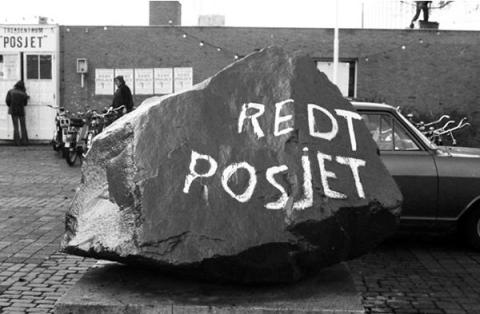Posjet
The first stone of the Eigen Huis (1962)
Goossens Building

When the university moved to the campus in 1962, a start was also made—some 700 meters east, on the Academielaan—of the construction of a Sports Center, a Mensa and society building 'Eigen huis' for student association TSC St. Olof, at that time the only corporal association in the city. The building was designed by Jos. Bedaux, just like Cobbenhagen, Koopmans and Goossens Buildings. At the opening, a boulder was placed, which became famous mainly because of the text painted on it in 1970: Redt Posjet (Save Posjet).
Posjet was a student center that existed from 1968-1980. The name is derived from the French La Pochette—Posjet was originally called a vestzaktheater. (small, intimate theatre) The center was located in a basement under the Mensa. Posjet began as a café but gradually offered pop concerts, film screenings, a weekly disco, theater performances, and Studium Generale programs. The student center also attracted public from outside, and developed into an open youth center—where non-students were also welcome. This led to a wider range of programming, but at a certain point also to student protests. For example, against the removal of 'their' posters in the so-called Kruitkelder (Powder Cellar), where people could reportedly sometimes “lean against the hashish fumes.”
By 1971, it became less popular. Bar sales plummeted, St. Olof had left, and the spirit of 1969 seemed extinguished. Professor Bosman remarked to students at ATSO, "But gentlemen, surely we cannot have an occupation every year for the sake of Posjet's bar turnover." Bankruptcy became inevitable despite a variety of measures, and Posjet closed in May 1971.
In 1972 the activities were restarted by the foundation 'Trefcentrum Eigen Huis' which turned Posjet into a center for engaged students, comparable to centers in other student cities, such as Doornroosje in Nijmegen and the Effenaar in Eindhoven. Posjet made a name for itself, inside and outside Tilburg, among other things because of concerts—mostly in the city center—by great artists like John Cale, Fischer-Z, The Sex Pistols, and Madness.
By the end of the 1970s, the party was over. The building was claimed by the university, which sought accommodation for the Theologische Faculteit. Posjet (where among others Zjef Naaijkens worked, frontman of the legendary pop group RK Veulpoepers BV) said goodbye in style, with a concert of U2 in the former Harmonie. The stone, for years, in front of the building where Posjet was housed and on which protests against the closure could be read, is now—without text—in front of Goossens building.
More about history and academic heritage
The Tilburg University academic heritage is a very diverse set of archives, visual materials, collections, devices, recorded stories, et cetera that relate to the history of the university.